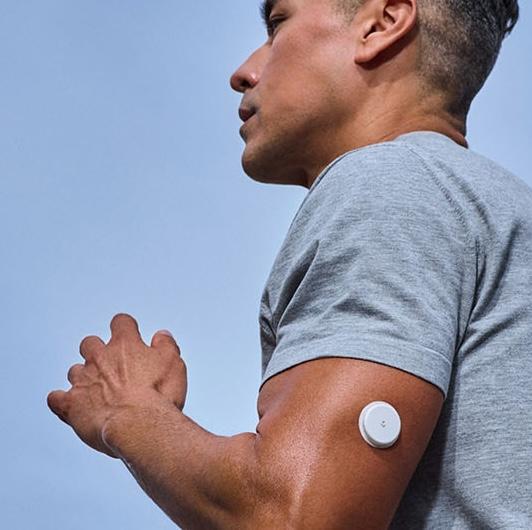11 marathon tips from a performance nutritionist
Nutrition is one of the most important tools in your marathon training kit. Read these tips to help you make the right choice for you and your performance goals.
Andrea Givens, MS, RD, CSSD,
Medical Affairs
Pamela Nisevich Bede, MS, RD, CSSD, LD,
Medical Affairs
Published:
March 28, 2025
Updated:
October 01, 2025
Read time:
8 minutes

What you should know:
Your body burns a mixture of fats and carbohydrates while you run, with intensity, fitness, and duration influencing the exact blend of nutrients used fuel.
Since the body only stores around 90-minutes' worth of carbohydrates to fuel hard-working muscles, you need to implement a fuelling plan to finish a marathon strong.1
During training, experiment with different sources of calories for energy and lean on tools like Lingo to learn if your nutrition plan is keeping your glucose steady and fuelling your performance.
Start Lingo today for just £59
Learn how your body responds to food and exercise with a 2-week plan*, no commitment.
Buy now
Running a marathon is a feat that only a small number of people attempt in their lifetime. Whether your goal is just to make it across the finish line or put up a new personal best, we’ve got some tips to help you.
The average marathon runner crosses the finish line in 4:30 to 5:00 hours,2 but the body can only store enough carbs to fuel hard-working muscles for around 90 minutes.1 Whilst running, your body burns a mixture of fats and carbohydrates, with pace, duration, and fitness influencing the exact blend of fuel.3 And, because marathons are a longer duration, some protein will be used for energy, too.
You can put in work to train your body to burn fat at higher intensities (becoming fitter and sparing stored energy), but to finish strong, you need to replace the carbs you’re burning via implementing a fuelling plan.
The phrase “nothing new on race day” exists for a reason, so prepare your body by practising this plan (including both nutrition and hydration) well ahead of time to increase the chances of a successful race.
1. Practice how and when you refuel
Muscles powering your run primarily rely on glucose. Trained individuals that consume enough carbohydrates in their daily diet can store around 90 minutes of fuel before needing to eat or drink during a run. But you’ll want to start replacing burnt fuel well before you hit the 90-minute mark.
Practice fuelling during training runs by consuming 30-60 grams of carbohydrates per hour. Your pace, fitness, and physiology may demand even more; some athletes require upwards of 90+ grams of carbohydrates from a blend of glucose and fructose per hour.3
Experiment with nutrition and hydration products that you like, can tolerate, and can carry.
Alternatively, if you’re used to fasted training or strictly follow a ketogenic diet and are more metabolically flexible, generalised carbohydrate recommendations may exceed your needs and gut comfort.
When adding in fuel, you may want to opt for sports nutrition products that have a lower glycaemic index, like slow-release carbs (typically containing amylopectin, a complex carbohydrate), healthy fats (energy balls, bars made with nut butters, or PB packets), and even exogenous ketones.
2. Strength train to get fast and avoid injury
Running a marathon means training will consist of mostly, well, running. But no plan is complete without strength training, which can help make you a faster runner and reduce your risk of injuries.5
Plus, strength training promotes metabolic adaptations in skeletal muscle,6 helping to improve how efficiently your body uses glucose and fats for fuel. Not only is this advantageous to your running performance, but healthy skeletal muscle is also at the foundation of optimising metabolic health.7
3. Make time to rest and recover
Arguably the most difficult part of a training plan is allowing your body to rest so that it can become stronger. The average adult needs 7-9 hours of sleep per night, and runners may need more.8
Sleep ensures physical restoration and also supports optimal metabolic function during the day.9
4. Plan your recovery nutrition
In addition to sleep, nutrient timing plays a critical role in recovery. Within an hour of finishing a workout or race (preferable sooner), take time to refuel and rehydrate.
Replace fluid losses by drinking water and electrolytes (like Pedialyte packets mixed into water or by consuming salty foods and potassium from fruits and vegetables).
Recover with a snack or small meal that includes high-quality carbohydrates along with fats and protein. This combination will help replenish your energy stores while preventing glucose ups and downs. Think: berries and low-sugar granola with Greek yoghurt, or whole grain pancakes with eggs.
Last but not least, be sure to prioritise protein. This hard-working nutrient helps keep glucose steady as you recover and is critical for stopping muscle breakdown and jump-starting muscle repair and growth.
Plan a post-run meal or snack that supplies at least 30 grams of protein and enjoy it within the “recovery window”— while sooner is always better, and most experts recommend refuelling within 2 hours after a training session.
5. Get to know your body with a CGM
Continuous glucose monitors (CGMs) are wearable devices that allow you to track your glucose levels in real time. This data can provide insights to help you assess how your nutrition and other habits impact your training and performance. Lingo is a continuous glucose monitoring system that can help you:
See how specific foods and drinks impact your glucose levels, pace, and performance.
Time your pre-workout meals and/or snacks to deliver adequate and sustained energy.
Ensure you’re eating enough to support long runs and avoid low glucose levels, which may impact energy and endurance.
Recover from your training load as glucose levels may be elevated after hard effort sessions.
Keep your glucose steady outside of training to support solid sleep, which is vital to recovery.10
With Lingo, you can review your glucose graphs indefinitely after your training sessions. You can also add the food and drinks you consumed and the exercise you performed to see patterns in your glucose and how this affects your performance.
Learn more about the benefits of using a CGM, even if you don’t have diabetes.
6. Practice your hydration plan
As race day approaches, be sure to keep an eye on the weather forecast. You can’t control what the weather will be, but you can be prepared to dial up or down your fluids and electrolytes.
A 2018 study on London Marathon runners found a ~3% detriment to finish time for every 5°C increase in temperature above 12°C.4 This means in warmer temperatures, you may be on course for longer.
Bring a bottle and plan to refill on course; the few extra seconds it will take are worth it. Proactively hydrate by sipping early and often while being cautious not to overhydrate.
Replace the electrolytes you lose through sweating by adding powered electrolytes to your water bottle or mix into a water cup handed out on course. Products like Pedialyte are formulated to replace what’s lost in sweat and aid in quick rehydration.
Set alerts on your watch or phone every 15-20 minutes to take a few sips. Drinking to thirst may work for some, but many athletes find they hydrate best when relying upon programmed drinking.
7. Check on-course nutrition in advance
You’ll find water at many points along the course, and most races also provide sports drinks, electrolyte beverages, and carbohydrate-rich gels.
Research what products your race will provide. If you plan on utilising on-course products, make sure you try them first during your long training runs to see if they work for you.
Remember to have a backup plan if the on-course products don’t work for you or are not available (or you run past them by accident).
8. Have a dress rehearsal
At least one long run during your training should be a full dress rehearsal, beginning the evening before the long run with a dinner that mimics what you’ll be eating before the race. Practice this tried-and-true dinner, allowing plenty of time (2-3 hours) to digest before falling asleep.
Eating increases glucose, metabolic rate, heart rate, and body temperature, but the opposite scenario needs to be happening to slide into quality sleep.
The morning of the long run, wake up and eat with the same foods, quantities, and timing that you plan to implement on race day.
Because your glucose will rise and then fall following your meal, avoid consuming foods in the 30-90 minutes before setting out. You can either back up the clock and fuel early before the race or fuel as you run, utilising sports drinks, gels, and whatever fuel source you prefer.
After fuelling, begin your run at race start time and test your planned nutrition and hydration.
9. Nothing new on race day (or in the days prior!)
You may be an adventurous foodie, but race week is not a time to try all the food samples at the race expo or new foods you encounter while exploring the city hosting the race. Likewise, race day is not the time to try out a new breakfast or anything new on-course in terms of your nutrition or hydration.
Instead, stick to foods that worked well and provided steady energy and gut comfort during training. Ideally, going into the race, you should know how your body will respond to your tried-and-true pre-run meal as well as any fuel you plan to take during the race.
10. Skip eating out the night before (unless it’s just to socialise)
You’ll need to top off your dinner plate with carbohydrates to complement your pre-race carb load, but it’s best to stick to familiar foods at this important meal.
Restaurant food portions can be much larger than you’re used to, sending your glucose spiking and disrupting an important night of sleep.
Pre-race “carb loading” has merit, and you can simplify this process by continuing to eat your typical balanced meals the week leading up to your race, making sure there’s high-quality carbs at every meal and snack. While your training tapers, these nutrients that would have been used to fuel your runs will be stored instead.
11. Race recovery begins at the finish line
You’ve strategically fuelled across training and throughout the entire race, but after you cross the finish line, you’ve got one more stop before the celebration begins. Take a moment for nutritional recovery.
Your body is primed to utilise nutrients during the post-race window so take advantage of increased blood flow to muscles.
Pack a protein shake in your drop bag at the finish line or ask your supportive fan crew to bring one along. Replenish, recover, and rehydrate with protein and fluids at the finish, then make your way to enjoy a celebratory meal.
Bonus tip: Trust your training and have fun!
A final note from Lingo
The right nutrition is arguably one of the most important tools in your marathon training kit. And with Lingo, you can peek behind the curtain and know if the fuel you’re using is the right choice for you and your performance goals.
Experiment with different sources of fuel and lean on Lingo to learn if your nutrition plan is keeping your glucose steady and adequately fuelling your run.
Map out what works: the types, amounts, and timing of nutrients and fluids taken during your run and in the recovery hours. Soon, you’ll have drawn up a smart and reliable plan for race day.
The Lingo system is not for medical use and intended for users 18 years and older. Lingo is not intended for diagnosis or management of any disease including diabetes.
The Lingo programme does not guarantee that everyone will achieve the same results as individual responses may vary. It is best to speak to your doctor for advice on starting any diet or exercise regime or if you have an eating disorder or a history of eating disorders.
© 2025 Abbott. All rights reserved. The biosensor shape and appearance, Lingo, and related brand marks are marks and/or designs of the Abbott group of companies in various territories. Other marks are the property of their respective owners.
ALB-02453 v2.0
Published:
March 28, 2025
Updated:
October 01, 2025
Read time:
8 minutes


Andrea Givens MS, RD, CSSD, is a Senior Medical Affairs Specialist and Health Coach at Lingo. Andrea has a passion for empowering individuals to leverage their unique physiology to optimise performance and health. She’s been a registered dietitian since 2010 and has been a board-certified specialist in sports dietetics since 2017. She holds master's degrees in both nutrition science and exercise physiology from San Diego State University.


Pamela Nisevich Bede, MS, RD, CSSD, LD, is a certified specialist in sports dietetics and an expert in nutrition communications. Pam earned her Bachelor of Science degree in Dietetics from Miami University and a Master of Science in Medical Dietetics from The Ohio State University. While at Abbott Nutrition, Pam was the Global Nutrition Lead at Zone Perfect Nutrition and Ensure and was previously the Manager of Nutrition Marketing at EAS Sports Nutrition.
A healthy choice for your inbox
Sign up for Lingo emails to get science-backed tips, special offers, and The Journey Newsletter.
Start Lingo today
for just £59
Learn how your body responds to food and exercise with a 2-week plan*, no commitment.
- 1 Lingo biosensor with minute-by-minute continuous glucose tracking
- Full access to the Lingo app. Designed for iPhone 11 device or later.
Shop now
Free shipping
*No commitment. This plan does not auto-renew (requires an iPhone 11 or later)

